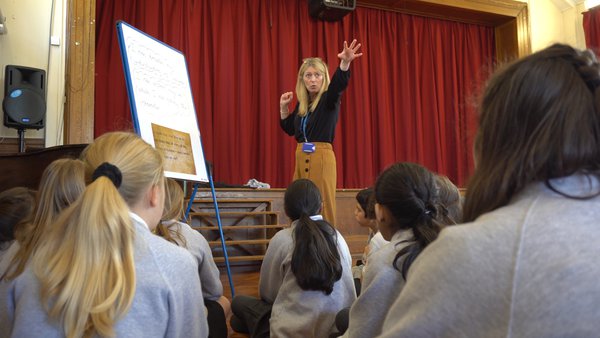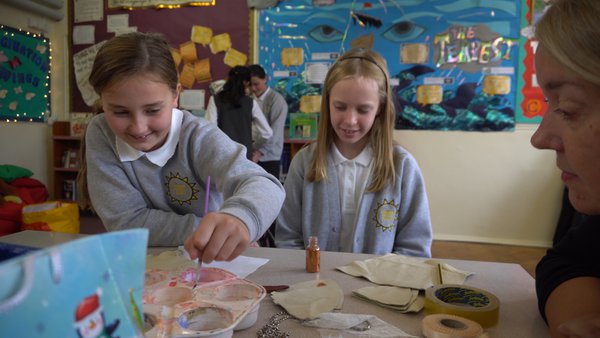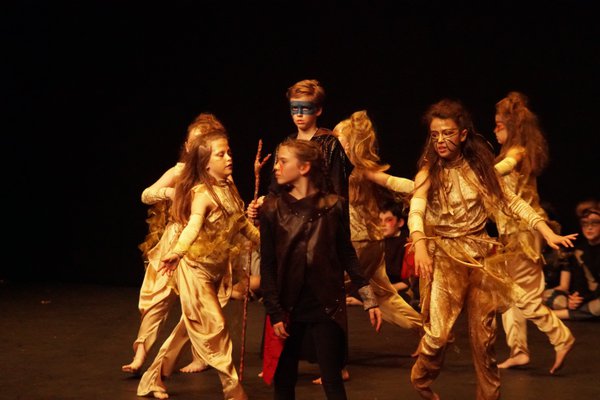Blog: Putting children at the heart of the creative process
Lisa Hall, Year 6 teacher and Cultural lead at Cragside primary school
18 November 2019
Our first creative project this year has centred around our involvement in the Shakespeare Schools Festival which takes place in the autumn term, culminating in a performance at The Northern Stage in early November. Having taken part in the project before, I knew the benefits but my aim this year was to use ‘pupil voice’ to drive the project forward by putting the children at the heart of the decision-making process.
On the first day of term, our classroom was transformed into an otherworldly place: a darkened room; debris scattered across desks; a storm soundscape playing in the background. From the outset, the children were hooked. Images of characters from the play, props and quotes were hung around the room and using the ‘I see… I notice… I wonder… technique’ I began to add structure to the children’s enquiry-based learning,

Lisa Hall with her year 6 class at Cragside primary school | Photo credit: Jay Bushby, Listen and Like
Through discussion and collaborative group work, the children quickly began to build up a picture of our new topic. There was a real buzz in the classroom and playground talk centred around everything Tempest!
Prior to casting the play and directly involving the children in the planning process itself, I felt it was important that the children had a good understanding of Shakespeare and the play.
Our initial literacy lessons centred around the language of Shakespeare. The children learnt about idioms and particularly enjoyed creating their own insults and throwing these at one another down ‘insult alley’. We then explored more formal aspects of the language and began to build up a glossary of terms. Following this, we then explored quotes from the play which resulted in many rich discussions centred around Shakespeare’s use of vocabulary and archaic sentence structures.

Year 6 children in a literacy lesson at Cragside primary school | Photo credit: Jay Bushby, Listen and Like
Whilst learning about the language of Shakespeare, we also began to explore the play itself. For this, I utilised the BBC Schools Radio webpage which provided an animated version of William Shakespeare’s 'The Tempest' set to modern music and split into 2-3 minute clips – ideal for classroom use and an invaluable resource. We began by time lining the main events, children worked in pairs to create fictitious ‘have you heard gossip telephone calls’ to one another and thoroughly enjoyed playing the role of news reporters interviewing survivors of the shipwreck.
The next stop on our immersive journey was to explore the themes and characters of the play. Once again, drama played an important role at this point. We used hot-seating and freeze frames together with thought tracking to embed children’s understanding of character. We also explored character relationships with particular emphasis upon the ‘servant and master’ role which is pertinent to the characters of Prospero, Ariel and Caliban.
Once fully immersed with a good understanding of the play, we began to involve the children in the planning process for our performance at The Northern Stage. We began by exploring the notion of setting and posed the question, ‘How could this be changed?’ Immediately, the children were brimming with ideas: the frozen north, outer-space, a desert, in the future, post-apocalyptic, under the sea, a rainforest. Rich group discussions promptly followed and creative writing tasks were used as a vehicle for the children to try out their ideas. After much deliberation and a year-group vote, the children finally decided upon a ‘post-apocalyptic desert wasteland’ theme.

Costume making with LSA June Wight, Cragside primary school | Photo credit: Jay Bushby, Listen and Like
From this point onwards, the pupil-voice aspect of our project began to gather momentum. As a year group, we further explored our wasteland setting and linked this to our science work on adaptation. We posed the question: ‘How could our costumes reflect not only the personality of the characters but the new setting that they inhabit?’ Art lessons were planned focusing on developing pencil drawing techniques; children used a range of mediums to explore colour tones and shades and mood boards were created outlining the children’s design ideas. Groups of children worked alongside our talented LSA, June Wright, to create costumes where they were given the opportunity to explore processes such as hand and machine stitching and fabric manipulation. They also used methods such as pleating, gathering, tearing and fraying to create desired effects.
Running alongside this, all children were involved in the creation of a soundtrack for the performance. This area of the project was led by music specialist, Rob Kitchin. During these sessions, the children explored how mood and atmosphere changes throughout the play and investigated how music could be used to reflect this. Children used a range of instruments and vocal/body percussion as well as found sounds to create compositions using digital technologies.

Pupils create their own sounds outside in the courtyard garden at Cragside primary school | Photo credit: Jay Bushby, Listen and Like
Over and above all the wonderful work taking place in class, we of course, have our actors who have been part of an after-school drama club. They have worked tirelessly to learn their lines and bring their characters to life. Pupil voice has been an important part of this process too. During rehearsals children have been encouraged to explore how movement, gesture and facial expression can be utilised effectively to convey character traits and mood. They have also been involved in decisions regarding character placement on stage and entrances and exits. Rich discussions during these sessions have also centred around the role of minor characters and the importance of such roles.
Our performance took place at The Northern Stage on 8 November. We secured tickets for the full cohort of children, we felt this was vitally important for a number of reasons: it gave the children the opportunity to experience live theatre; see their peers and other schools perform but most importantly highlighted the importance of their contributions to the project itself.

Final performance at Northern Stage | Photo credit: Jay Bushby, Listen and Like
It has been a joy to see children working collaboratively to make decisions; working together to solve problems and ultimately feeling empowered to be leaders of their own learning. Putting the children at the heart of the creative process was my aim from the outset and I truly believe that this has been achieved.

Final performance at Northern Stage | Photo credit: Jay Bushby, Listen and Like

